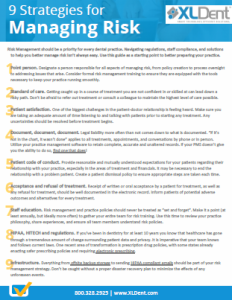4 Things You Should Know About Risk Management
Posted March 7, 2017 by Alexa S.
Preventive care is something that you stress to your patients every day. Establishing a preventive risk management plan, reducing risky behaviors, and regular maintenance are crucial to running a successful and prepared practice. We’ll explore a few ideas today that will help you reduce or even eliminate potential vulnerabilities in the long run.
To start, determine a point person in your practice to oversee risk-management issues, recognize potential problems early and be proactive in investigating and implementing preventive measures. The point person should be responsible for reviewing office policies on a routine basis and ensuring that all team members are adhering to the established policies. For practices that do not have documentation, the risk management point person should work to identify areas of risk and begin creating policies to mitigate them. This may include patient dismissal, chairside documentation, complex treatment plan or insurance billing procedures.
A key element to a well-rounded risk management plan is patient satisfaction. Patients who repeatedly feel their concerns are not being heard may soon become unhappy, and are more likely to file a complaint against your practice. Patients who like their dentist and office team are less likely to get to the point of a malpractice suit; this is why it is essential for you and all staff members to provide quality care to every patient. Little things that you may not consider to be a big deal can cause a normally happy patient to become dissatisfied. For example, you have a patient who has to wait 30 minutes for an appointment, doesn’t get an apology, and feels rushed through their visit. The result is a higher potential for the patient to feel discouraged and even disrespected. Every member of your team plays a role in maintaining a positive experience for patients. A good relationship with a patient can often prevent a small issue from becoming a risk nightmare.
Are you positive that all of your patients have reasonable expectations surrounding their treatment outcome before you provide care? If not, now is the time to reassess your treatment presentation and education processes. It is important to make sure you clearly communicate and that your patients fully understand procedures and their anticipated outcome prior to providing treatment. This should be done verbally, but also make sure that you retain complete, accurate, and unaltered records for each patient. After completing thorough examinations, it is important to document your findings in as much detail as possible. Be prepared in the event you encounter a lawsuit by getting in the habit of relying on a system designed for narrative progress notes. The clinical narrative will help you create a comprehensive picture of the care provided as well as the patient consent to treatment.
Finally, if you aren’t already doing a regular team huddle – start one! Why? Team huddles work! Being able to communicate face-to-face with your team makes these meetings more personal and likely to garner more attention. By having team huddles, you open the door to your team to express any areas of concern or processes they do not understand. Use the huddle to focus on key practice issues, and educate and align your team on the specifics surrounding managing risk.
Assessing and addressing legal liabilities in areas of treatment, documentation and relationships is a necessary part of risk management. Reviewing all areas of your dental practice will help you provide the best possible patient care while reducing uncertainties. If you haven’t reviewed your risk management plan recently, take a look at 9 Strategies for Managing Risk and get started today.

 Subscribe
Subscribe Subscribe
Subscribe



